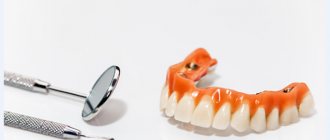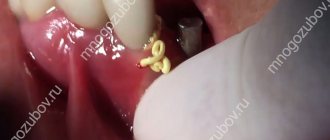Modern dental prosthetics can completely restore the aesthetics of the dentition and its chewing functions. People may face the need for surgical removal at any age. Among the achievements of orthopedic dentistry, anyone can choose a suitable replacement option. Dental prostheses are produced in different types, differing in the material of manufacture, cost, and service life. For the production of structures, alloys of precious metals, ceramics, special plastics, polymers, nylon and other types of raw materials are used.
There are two types of prosthetics after tooth extraction:
- Removable dental structures can be removed and put on by the patient as needed. The products are attached to the supporting teeth using hooks or micro-locks. For edentulous patients, models are used that are fixed to the gums using suction cups or a special gel.
- Fixed dentures are installed in the jaw (implants) or attached to supporting teeth (bridges).
Each category is represented by several options. Among them, dentists select the appropriate solution based on the condition of the oral cavity and the health of the patient.
Depending on the service life of the products, temporary and permanent dentures are distinguished. Models of the first type are designed to last only a few months. The products are used to temporarily close the postoperative gap.
Fixed dentures remain the most popular way to restore the beauty of a smile. This replacement option is more convenient compared to removable devices. It is easy to care for and helps preserve the natural functions of the dental system. Permanent prosthetics are performed in different ways:
- The installation of crowns made of metal ceramics or a metal alloy is performed on a previously prepared tooth. This method is used if the root is intact, but the top is destroyed.
- Implantation of one or more teeth involves inserting an artificial root into the jaw. A permanent or temporary crown is placed on it. This method is indicated for complete or partial edentia. Sometimes doctors use an implant as a support for a bridge.
- Bridges are placed after the amputation of several teeth located nearby.
- Adhesive structures are secured using an adhesive solution. In this case, there is no need to depulp the adjacent teeth. This restoration method is one of the most technologically advanced in orthopedic dentistry.
Prosthetics after tooth extraction and indications for the procedure
Installation of a denture allows you to completely restore the functional and aesthetic properties of the jaw apparatus. The indication for the procedure is single or multiple damage to the jaw as a result of trauma, surgical amputation due to advanced caries, or other diseases of the oral cavity.
If the crown is partially destroyed, a microprosthesis is installed instead of the usual one. This group includes inlays, veneers and ultraneers. The products effectively solve aesthetic problems with minimal trauma to natural bone and gum tissue.
External changes
Due to missing teeth, facial muscles weaken, facial tissues begin to sag, which visually increases a person’s age and adds 7-10 years to it. The chin becomes sharper, the lower jaw protrudes above the upper jaw, the corners of the lips and the tip of the nose droop. This changes the overall facial expression, which constantly appears gloomy and dissatisfied to others. From a close distance, the absence of a tooth is clearly visible, even if it is not part of the smile.
Contraindications
Thanks to the variety of techniques for each person, you can choose a way to restore the beauty of your smile. All dentures have indications for use and contraindications. The decision to replace a lost element after amputation is made by the attending physician based on the results of dental diagnostics, taking into account the age and condition of the body.
As for the general reasons, experts do not recommend performing surgical procedures if you are pregnant, undergoing rehabilitation after a serious illness or complex operation, or are sick with ARVI. You should not install implants or dentures during periods of exacerbation of chronic diseases, exhaustion or acute stress.
Tell your doctor if you are allergic to anesthetics or take any medications. Some drugs affect blood clotting and the rate of tissue regeneration. This can create problems during the procedure and while the wound is healing.
Often, poor oral hygiene is an obstacle to treatment. This temporary contraindication can be eliminated through therapeutic measures.
Diagnosis: complete absence of teeth
Partial edentia means that the patient is missing several teeth. Multiple edentia is a condition in which more than 10 teeth are missing. If the patient has lost the entire dentition - on one or both jaws, then the doctor diagnoses “complete edentia”. As a rule, people in adulthood face this problem, but in exceptional cases, this diagnosis can occur in young people and even children.
There are two types of edentia.
- With primary adentia,
a person is born with dead/undeveloped tooth rudiments. Even partial primary adentia occurs in only 1% of cases of all dental anomalies, and complete primary adentia is an extremely rare diagnosis. The congenital absence of tooth buds is caused by various hereditary factors or diseases that provoke disturbances in the development of the dental plate. Thus, the cause of congenital adentia can be ichthyosis, hypothyroidism, pituitary dwarfism, and infectious diseases. - Secondary complete adentia
is most common in adulthood, affecting about 20% of people over 65 years of age. This form is considered acquired; it is provoked by:
- metabolic disorders;
- age-related changes;
- injuries to teeth and jaw;
- gum disease;
- caries and its complications.
Periodontitis, periodontal disease, periostitis, pulpitis, periodontitis without high-quality and timely treatment can lead to complete or partial adentia even at a young age.
Installation of the prosthesis immediately after removal (within 24 hours)
Clients are always interested in how many days after an injury or surgery they can get dentures. Dentistry has express methods for instantly eliminating smile defects. There is no need to hide an ugly gap from others and experience discomfort when communicating! We are talking about simultaneous implantation, which is performed in one stage. The dentist installs an artificial root into the resulting hole and immediately puts on a crown, which is prepared in advance. It creates a load on the jaw apparatus and prevents atrophy.
Another option is immediate dentures, which are temporary and are designed for 3-4 months of use.
Problems with other teeth
Neighboring teeth gradually move to the place of the removed tooth. This leads to malocclusion. Also, in the first months after tooth loss, active bone resorption occurs. A depression forms in the gum above the empty socket. Because of this, the mucous membrane looks ugly.
The absence of even one tooth increases the load on other dental units. As a result, the enamel can wear off faster. This provokes the appearance of caries.
Misaligned teeth are more difficult to clean. Microbial plaque begins to form in hard-to-reach places. Gradually it turns into stone, provoking inflammatory processes and the progression of caries.
Expert opinion
Roman Borisovich Alekperov
orthopedic dentist
Experience: 24 years
If you are just planning to visit a surgeon for tooth extraction, consider the option of one-stage implantation. This unique method involves placing an implant into the resulting socket immediately after extraction. No additional manipulations - incisions or detachment of a mucosal flap, as with the classic protocol - are performed. This gentle method will allow you to resolve the issue of tooth restoration immediately at the time of its removal. Important: there are contraindications for immediate implantation! Please clarify the possibility of its use in your case during your consultation.
Prohibition on instant implantation
In some cases, immediate implantation is not possible. This primarily applies to patients with atrophied bone tissue, in which case a lengthy process of osteoplasty will be required before surgery. It will also be impossible to implant a pin if there are fistulas, ulcers, cysts and other formations in the oral cavity. A painful condition of the mucous membrane or tongue is also a temporary contraindication.
Implantation is prohibited even if a person has such serious diseases as oncology, diabetes, vascular and heart disorders, problems with the thyroid gland and immune system, tuberculosis, HIV, diseases of the circulatory system, allergies to the materials and drugs used, mental disorders , prolonged depression, etc.
In rare cases, it happens that the doctor was ready for immediate implantation, but during the course of work the situation changes. As a result, implantation has to be delayed for several weeks until the soft tissues have healed after tooth extraction.
What types of dental prosthetics exist if only one tooth is missing?
If the destruction is so great that there is nothing left to save, you will still have to resort to removal. So, one tooth had to be removed, and now there is an unsightly empty space in its place. You should not wait for the “neighbors” in the dentition to move into the vacant space, disrupting the bite and interfering with normal chewing of food. It is better to immediately contact an orthopedic dentist, who will select the appropriate way to return the “prodigal” tooth to its place. There are several different ways to do this:
- Implantation.
A method that today is unrivaled in terms of reliability, durability and scope of function restoration. In modern dentistry it is considered simply ideal. If it is possible to carry out implantation, it is better to opt for this method of prosthetics. A titanium “artificial root” is screwed into the jawbone, onto which a crown made of metal-free ceramics or metal-ceramics is then installed. A very reliable and durable method that not only returns aesthetics to the dentition, but also almost completely restores its functions. - Bridge prosthesis.
A dental “bridge” is made of three interconnected crowns: one replaces a missing tooth, and the remaining two are attached to the supporting teeth and play the role of “bearing beams” of the bridge. The advantages of this method are affordable price and reliability, the disadvantages are the need to grind the supporting teeth, as well as the need to remove the entire prosthesis if it breaks. - Adhesive prosthetics .
The method is similar to installing a conventional bridge with support on the teeth adjacent to the defect. But at the same time, turning these “supports” is not required: the doctor will simply make micro-incisions on the tooth enamel, into which he will place a strong fiberglass thread and secure it with the help of composites. A more gentle and faster method of prosthetics than installing a “classical” bridge, but not as durable and reliable (recommended only for front teeth that do not bear the same load as chewing teeth). - CBW prosthetic system with micro-locks
. Here, too, neighboring teeth are used as a support for the prosthetic crown, but they do not have to be ground down. It will be enough to make small holes to fix the micro-locks that will hold the crown. A fairly reliable and quick way to restore a defect, however, dentists consider it not very durable and often recommend using it as a temporary option. - Immediate prosthesis, or “butterfly”.
What could be easier than installing a neat, removable structure with nylon or metal wire fastenings? Such a prosthesis does not scratch the enamel, is quickly installed and removed just as quickly, and does not require grinding of dental tissues. It would seem like a patient’s dream. But in fact, an immediate denture is quite uncomfortable when worn constantly, it is short-lived and is not intended to permanently replace a lost tooth. This is a temporary structure, which is usually installed for the period while a permanent prosthesis is being made.
Comparing prices: which method is more affordable?
The cheapest option is an immediate prosthesis, its cost will be about 2000-5000 rubles. But, as already mentioned, this is a temporary solution: you can wear it for no more than 2-3 months, and then you will need to change it to a permanent structure. An adhesive prosthesis will cost about 6,000-10,000 rubles, which is a very reasonable price for good aesthetics and reliable fixation. However, in terms of durability, adhesive structures are inferior to the same bridges (their price is the sum of the cost of individual crowns; if one crown costs 20-40 thousand rubles, then for a bridge this amount should be multiplied by three). Implantation will cost 20-70 thousand rubles, depending on the type of implant chosen. That is, implantation costs about the same as a good bridge structure, but at the same time it is much more reliable, more durable and does not require grinding of supporting dental units.
Psychological aspects of tooth loss
Psychological effects range from minimal to neurotic. It gets to the point that people are not able to wear dentures at all, and thinking that they will have to communicate with someone, they do not leave the house at all.
- Fear of an awkward situation if the prosthesis accidentally detaches.
- Losing teeth affects relationships with the opposite sex
- The occlusal (chewing) load is reduced, and the patient cannot afford to eat all the food he would like.
- Inability to eat in public.
- Speech problems. Diction problems in patients can be very serious.
Aesthetic consequences
The presence of even one gap in the dentition can change the proportions of the face over time. Age-related aging processes accelerate, become more noticeable, and intensify:
- due to alveolar bone resorption, facial height decreases;
- vertical lines become more noticeable in the area of the lips and chin, making the face look rougher;
- The bite gradually changes, which can cause the proportions of the lips to be disrupted and the chin to change;
- with edentulism in the upper jaw, the nasolabial groove deepens faster and more noticeably, which is why the face looks older;
- It is possible to form a double chin if the attachment of the muscles to the body of the lower jaw is disrupted and their tone decreases.
Work examples
(images are clickable)
What does it look like?
The implant surgeon together with the orthopedist, at a free consultation, decides whether this type of prosthetics is possible, namely: is the bone mass, its thickness, and the condition of the bone tissue sufficient. It is necessary to take into account how and why the patient lost all his teeth - the result of injury, age or a systemic disease of the body.
A surgical template is made individually for the patient, after which implantation can begin. After the specialists have examined the patient and studied his orthopantomogram, if the verdict is positive, the patient is sent to a computed tomography scan, which will allow all bone structures to be seen in great detail and anatomical measurements to be measured down to the micron. structures and make “markings” for planning the operation.
First stage
The first stage is the installation of eight implants on one jaw. This amount often raises questions from patients and disputes among doctors. But you can’t fool physics, and orthopedics is an area where the main processes are physical, and therefore eight implants are needed to withstand the necessary load of a full arc.
Second phase
The second stage begins after 3 months: a control image is taken - an orthopantomogram, assessing how the implants have healed. If successful, the surgeon places eight healing abutments. The patient walks with them for 2 weeks.
Third stage
Then the orthopedic dentist begins work.
At the first appointment, impressions are taken and the laboratory begins to manufacture a “new jaw”. The technicians’ task is not easy: using eight implant supports, attach an arch, usually consisting of fourteen teeth, to them.
The doctor’s task is to fix the structure so that the patient cannot (and does not want) to remove the bridge and put it in a cup.
The patient will have no less difficult work: getting used to the feeling of suddenly having a “mouthful of teeth” is not easy, but the result is worth it!
The entire journey will take 4 months.
How much does this kind of work cost?
- implantation - 24,000 x 8 = 192,000 rubles;
- production of a surgical template = 4000 rubles;
- control shot - 900 x 2 = 1800 rubles;
- installation of shapers 3000 x 8 = 24,000 rubles;
- crowns for implants - 13,000 x 8 = 104,000 rubles;
- metal-ceramic crowns 7500 x 6 = 45,000 rubles;
- total - 370,800 rubles (payment is made in stages over 4 months).
Scares
option for
370,800 rubles
? Perhaps you don't need it.
Two complete removable dentures
will also solve the problem of complete absence of teeth.
Price: 30,000 rubles. The duration of prosthetics is 2-3 weeks .
Savings compared to implantation - more than 90%!
4 times
faster In conclusion, I would like to remind you that keeping your teeth intact and beautiful is much easier and cheaper. Visit your dentist regularly for examinations, come for professional hygiene once every six months, and immediately go to the doctor if the first signs of the disease appear.
Be healthy!
Here are answers to frequently asked questions from our clients about dental prosthetics. If you have a question, send it to us using any method specified in Contacts.
- What is the price for prosthetics? For crowns? For removable dentures?
Prices for prosthetics vary depending on the complexity of the work and the material. Metal-ceramic crown - 9,000, the cheapest crown is metal - 6,000 rubles, the most expensive is zirconium (about 22,000 rubles). Removable dentures - from 17,000 rubles per denture.
- What are crowns made of? Who is the manufacturer?
The most popular crowns are metal-ceramic. They have an alloy base (CoCr, NiCr) and a ceramic coating. More expensive crowns: all-ceramic (without a metal base) and zirconium (zirconium dioxide base and ceramic lining). All crowns are made individually according to your impressions in a laboratory in Moscow. The material (ceramics) used for production is produced in the USA by Densplay.
- What is included in the price of a crown?
The cost of a crown includes taking impressions, making models, determining the bite, making a crown in the laboratory, fixation, and correction.
- What is the guarantee for crowns?
Warranty for fixed prostheses (crowns and bridges) 1 year. On average, a crown lasts about 10 years.
- How long will the crowns cost?
Metal-ceramic crowns usually last about 10 years, but we often see patients who have them for 15 or 20 years. In any case, it is important to understand that caring for both your teeth and crowns will significantly extend their service life.
- How long does prosthetics take?
The duration of prosthetics depends on the volume and complexity of the work. Everything is individual: from 7 days to a month.
- Which prosthesis is the best?
The best prosthesis is the one that suits you. Crowns, bridges, removable dentures, implant prosthetics... There are many types of prosthetics, as well as clinical cases when it is necessary. We recommend going to several clinics for a consultation to hear the opinions of different doctors.
The prices given in the text are indicative and may differ from actual prices. Current prices can be found in the “prices” section.
Photos of the dental offices of the clinic Our Dentist in Krasnogorsk
(images are clickable)











